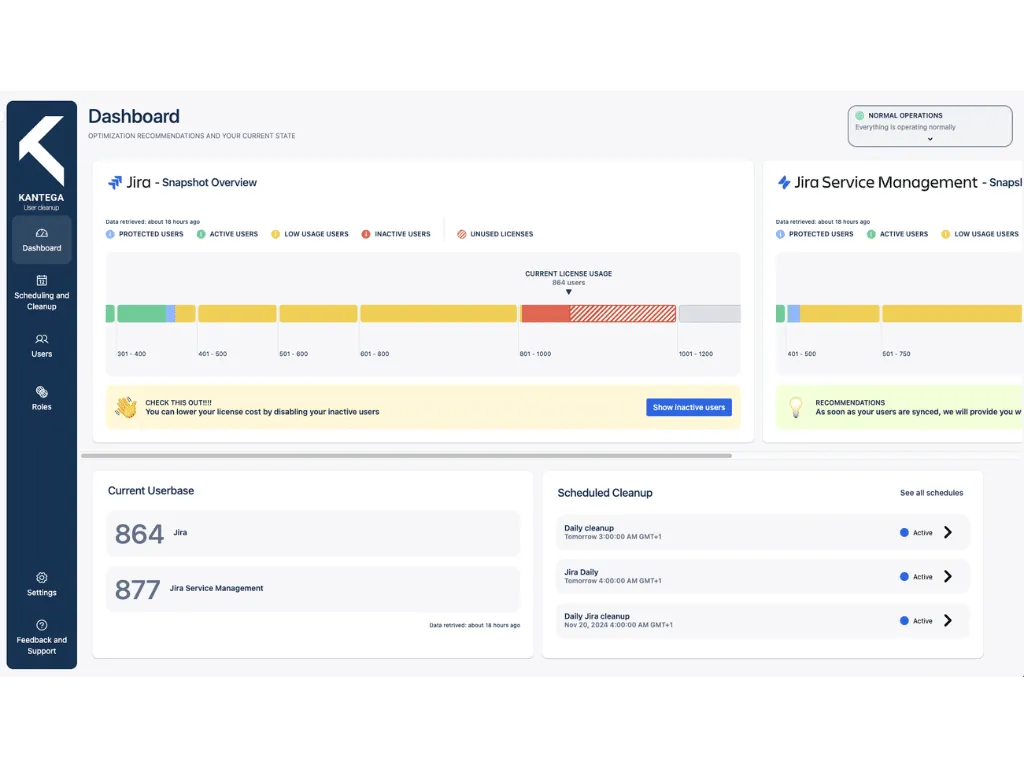A bet without risk?
People like to bet. The element of play combined with the thrill of risk and the feeling of being able to influence your own luck is irresistible to some.
The global market for sports betting alone is said to be three trillion dollars. But people don’t just bet on soccer matches and horse races – you can bet and win big on just about anything, including the US presidential race.
These bets have one thing in common: you have something to lose. In contrast, we’d like to offer you a bet where your company can only win. Your stake is exactly zero!
We bet that we can find optimization potential in your organization’s existing Atlassian licenses.
Atlassian licenses and various influencing factors
At first glance, this offer may raise a question mark. After all, the topic doesn’t seem that complex: Your company pays X amount per user per month for a product. Let’s say Jira, right? What is there to optimize?
But even at second glance, various factors become apparent that make things more difficult. For example, user tiers are also relevant in the cloud: The size of your product instance affects the per-user costs. The question of whether billing is monthly or annual also influences the prices.
These are just some of the obvious aspects. In fact, the topic of Atlassian licenses is much more complex than many customers assume, especially in larger and bigger organizations. And it is in the nature of complex topics that they are initially difficult to grasp, difficult to handle and full of surprises.
We want to help you untangle the complexity.
Product instances in your Atlassian infrastructure
Getting started with the Atlassian Cloud is very easy. You don’t need any technical infrastructure, and no administrative preparatory work is required. A product instance is therefore quickly created - and sometimes quickly forgotten.
How many product instances do you actually have across your teams and departments? Are they all (still) necessary? Are they possibly being used for redundant work and purposes? A comprehensive inventory across your organization can probably already reveal some potential savings.
Over-licensing
Do you know how many users are actually actively working in the Atlassian systems and how many inactive users are still being supplied with licenses? Is your organization paying fees for people who are no longer part of the company? Or for teams, departments or locations that do not work with Atlassian products at all, for example because they use alternative solutions? Do all employees really need access to product X?
Organizations are apparently burning through an astonishing amount of money by over-licensing software: in the USA and Great Britain alone, this is said to amount to 34 billion US dollars a year!

One way to begin understanding what your licensing landscape looks like is by trying out the Automated User Cleanup & Deactivation application for Jira, JSM and Confluence for Atlassian Cloud and Data Center. This application gives admins an overview of their company’s license consumption, activity vs. inactivity, and unused licenses, as well as options to cleanup and deactivate users and groups. It’s an easy way for admins to optimize their license base and off-boarding inactive users.
Through a comprehensive dashboard, admins can quickly see how licenses are distributed and the user tiers they fall into. This insight is invaluable for planning ahead, such as determining when an upgrade to the next user level might be necessary.
If this app sounds interesting to you, watch our quick video overview with Kantega to see the app in action and learn how it can save you time and resources. If you’d like to book a 1:1 demo, click here.
Resource requirements
One of the most important value propositions of the cloud is scalability - and this works both ways. Atlassian offers flexible subscription models that allow companies to adjust their costs to actual needs, even in the short term. The scalability of the cloud allows your organization to scale resources up or down depending on project requirements, optimizing the cost structure.
However, the second point, i.e. scaling back resources - for example after the completion of a large project - is not consistently pursued in many cases. It is worth regularly comparing current requirements with the license structure.
Marketplace apps
There are thousands of apps for every conceivable use case on the Atlassian Marketplace. This is where partners and third-party providers offer their solutions, which extend the Atlassian core products with specific features. Your Atlassian products most likely also have various paid apps installed. Do you have an overview?
Are all these specific use cases still needed in your teams? Are some app functions perhaps long since obsolete, for example because the core products themselves now have corresponding features? Is there perhaps a new app that combines the use cases of several individual solutions in one product? There is significant potential for improvement waiting to be uncovered in almost every organization.
License optimization without restricting productive work
As you can see, there are probably many unanswered questions about the Atlassian licensing structure in your organization. Not all topics may be equally relevant in your specific case, but all in all, there will probably be several opportunities to reduce costs without affecting the productive work of the teams.
Are you in on the bet? Our experienced licensing team is looking forward to talking to you and discussing a systematic analysis of your company’s license landscape! Get in touch with us by filling out the form below. We’re looking forward to hearing from you.

